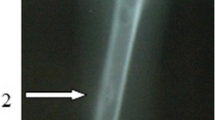Abstract
The purpose of this study was to investigate the effects of Bioglass 45S5® and Biosilicate®, on bone defects inflicted on the tibia of rats. Fifty male Wistar rats were used in this study, and divided into five groups, including a control group, to test Biosilicate® and Bioglass® materials of two different particle sizes (180–212 μm or 300–355 μm). All animals were sacrificed 15 days after surgery. No significant differences (P > 0.05) were found when values for Maximal load, Energy Absorption and Structural Stiffness were compared among the groups. Histopathological evaluation revealed osteogenic activity in the bone defect for the control group. Nevertheless, it seems that the amount of fully formed bone was higher in specimens treated with Biosilicate® (granulometry 300–355 μm) when compared to the control group. The same picture occurred regarding Biosilicate® with granulometry 180–212 μm. Morphometric findings for bone area results (%) showed no statistically significant differences (P > 0.05) among the groups. Taken together, such findings suggest that, Biosilicate® exerts more osteogenic activity when compared to Bioglass® under subjective histopathological analysis.


Similar content being viewed by others
References
Claes L, Willie B. The enhancement of bone regeneration by ultrasound. Prog Biophys Mol Biol. 2007;93:384–98. (Review).
Gautier E. Sommer guidelines for the clinical application of the LCP. Injury. 2003;34:B63–76. (Review).
Hench LL, Xynos ID, Polak JM. Bioactive glasses for in situ tissue regeneration. J Biomater Sci Polym Ed. 2004;15:543–62.
Moura J, Teixeira LN, Ravagnani C, Peitl O, Zanotto ED, Beloti MM, et al. In vitro osteogenesis on a highly bioactive glass-ceramic (Biosilicate). J Biomed Mater Res A. 2007;82:545–57.
Thomas MV, Puleo DA, Al-Sabbagh M. Bioactive glass three decades on. J Long Term Eff Med Implants. 2005;15:585–97.
Xynos ID, Edgar AJ, Buttery LD, Hench LL, Polak JM. Ionic products of bioactive glass dissolution increase proliferation of human osteoblasts and induce insulin-like growth factor II mRNA expression and protein synthesis. Biochem Biophys Res Commun. 2000;276:461–5.
Loty C, Sautier JM, Loty S, Hattar S, Asselin A, Oboeuf M, et al. The biomimetics of bone: engineered glass-ceramics a paradigm for in vitro biomineralization studies. Connect Tissue Res. 2002;43:524–8.
Gough JE, Notingher I, Hench LL. Osteoblast attachment and mineralized nodule formation on rough and smooth 45S5 bioactive glass monoliths. J Biomed Mater Res A. 2004;68:640–50.
Wheeler DL, Montfort MJ, McLoughlin SW. Differential healing response of bone adjacent to porous implants coated with hydroxyapatite and 45S5 bioactive glass. J Biomed Mater Res. 2001;55:603–12.
Vallet-Regi M. Ceramics for medical applications. J Chem Soc Dalton Trans. 2001;78:97–108.
Dieudonne SC, van den Dolder J, de Ruijter JE, Paldan H, Peltola T, van‘t Hof MA, et al. Osteoblast differentiation of bone marrow stromal cells cultured on silica gel and sol–gel-derived titania. Biomaterials. 2002;23:3041–51.
Ribeiro DA, Matsumoto MA. Low-level laser therapy improves bone repair in rats treated with anti-inflammatory drugs. J Oral Rehabil. 2008;35:925–33.
Matsumoto MA, Ferino RV, Monteleone GF, Ribeiro DA. Low-level laser therapy modulates cyclo-oxygenase-2 expression during bone repair in rats. Lasers Med Sci. 2009;24:195–201.
Weibel ER, Kistler GS, Scherle WF. Practical stereological methods for morphometric cytology. Philadelphia: WB Saunders Company; 1970. p. 58–82.
Claes L, Rüter A, Mayr E. Low-intensity ultrasound enhances maturation of callus after segmental transport. Clin Orthop Relat Res. 2005;430:189–94.
Ribeiro DA, Hirota L, Cestari TM, Ceolin DS, Taga R, Assis GF, et al. J Mol Histol. 2006;37:361–7.
Reilly GC, Radin S, Chen AT, Ducheyne P. Differential alkaline phosphatase responses of rat and human bone marrow derived mesenchymal stem cells to 45S5 bioactive glass. Biomaterials. 2007;28:4091–7.
Vogell M, Voigt T, Gross U, Muk C. In vivo comparison of bioactive glass particles in rabbits. Biomaterials. 2001;29:357–62.
Oonishi H, Kushitani S, Yasukawa E, Iwaki H, Hench LL, Wilson J, et al. Particulate bioglass compared with hydroxyapatite as a bone graft substitute. Clin Orthop Relat Res. 1997;334:316–25.
Cruz ACC, Pochapski MT, Daher JB, Silva JCZ, Pilatti GL, Santos FA. Physico-chemical characterization and biocompatibility evaluation of hydroxyapatites. J Oral Sci. 2006;48:219–26.
Nandi SK, Kundu B, Datta S, De DK, Basu D. The repair of segmental bone defects with porous bioglass: an experimental study in goat. Res Vet Sci. 2008;2:162–73.
Bretcanu O, Misra S, Roy I, Renghini C, Fiori F, Boccaccini AR, Salih V. In vitro biocompatibility of 45S5 Bioglass((R))-derived glass-ceramic scaffolds coated with poly(3-hydroxybutyrate). J Tissue Eng Regen Med. 2009;2:139–48.
Vargas GE, Mesones RV, Bretcanu O, López JM, Boccaccini AR, Gorustovich A. Biocompatibility and bone mineralization potential of 45S5 Bioglass-derived glass-ceramic scaffolds in chick embryos. Acta Biomater. 2009;5:374–80.
Acknowledgments
The authors thank to Fapesp (grant 07/08189-9), CAPES (Nanobiotec network 2009), and CNPq for generous financial support in the period 2007–2009.
Author information
Authors and Affiliations
Corresponding author
Rights and permissions
About this article
Cite this article
Granito, R.N., Ribeiro, D.A., Rennó, A.C.M. et al. Effects of biosilicate and bioglass 45S5 on tibial bone consolidation on rats: a biomechanical and a histological study. J Mater Sci: Mater Med 20, 2521–2526 (2009). https://doi.org/10.1007/s10856-009-3824-z
Received:
Accepted:
Published:
Issue Date:
DOI: https://doi.org/10.1007/s10856-009-3824-z




